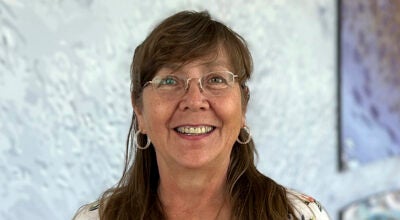Lefse and laughter: St. Olaf members were on a roll with preparation of popular Scandinavian food
Published 7:01 am Sunday, October 1, 2017
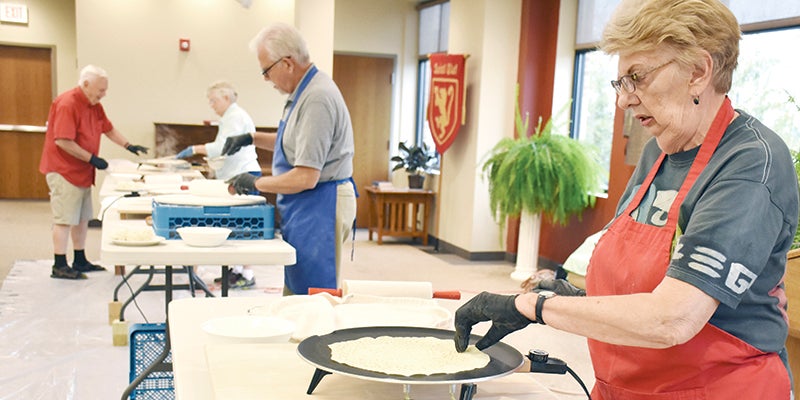
- Vernice Bishop checks the heat on her griddle during the lefse rolling at St. Olaf Lutheran Church. Bishop is one of the organizers of the annual event that has been held for decades at the church. Deb Nicklay/deb.nicklay@austindailyherald.com
During a day of lefse rolling at St. Olaf Lutheran Church, laughter and dough are meted out in equal measure.
Well, you need some good-natured joking to get through the 600 pounds of potatoes, and cooking the 300 dozen lefse that will result from those russets.
“It’s our heritage,” said Vernice Bishop who, with Ila Akkerman, heads up the annual Norwegian lefse-making, along with 30-plus volunteers. “It’s our history.”
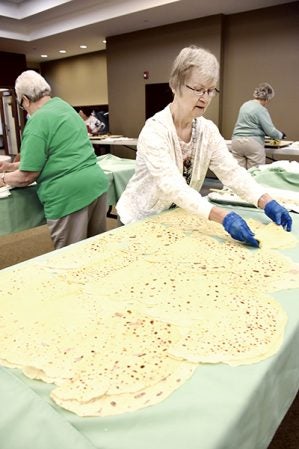
Karen Olson inspects and cools the lefse rounds. Although Swedish by heritage, “I work well with the Norwegians,” she said with a laugh. Photos by Deb Nicklay/deb.nicklay@austindailyherald.com
No one quite knows how long St. Olaf has been making the Norwegian treat, except that mention is often made from the volunteers of their grandmothers and mothers being involved in the church preparation of the soft Norwegian flatbread.
This year, the tradition may be treasured even more: it is the church’s 150th anniversary year.
Joanne Worlein, one of the cooks, said her mother-in-law, Margaret Worlein, “started bringing me here 45 years ago.”
The sale of the lefse is WELCA’s (Women of the Evangelical Lutheran Church of America) major fundraiser, and members will work in three rounds of lefse-making to complete their sale season. Two rounds of preparation will be held before their Scandinavian Festival and Bazaar on Oct. 14; one more round will be held after that celebration, for holiday pre-sales.
A dozen sells for $20, “and they fly out of here” when put out for sale, Bishop said.
The preparation for Scandinavian Day began last Sunday, when the potatoes were boiled and riced; on Monday and Tuesday, the dough was made, rolled, and cooked on 12 round griddles placed around the fellowship hall of the church.
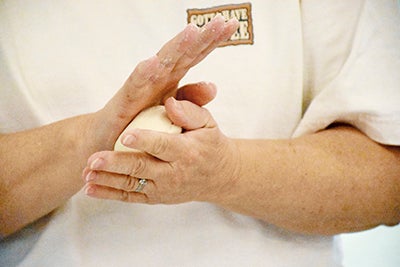
Lefse is rolled and flattened out before going on the griddle.
The flour, butter, milk and potatoes were mixed into a dough to just the right consistency — a texture, it seems, that veterans like Bernie Bishop, Vernice’s husband, know only by touch.
“He used to work with cement and he said that consistency, when you mixed the cement, was about the same for lefse dough,” Bishop said, chuckling.
Georgia Brenden then divided the dough into balls about the size of baseballs.
The dough was then brought to the cooks, where they flattened the dough and then used a rolling pin to form it into an 8- to 10-inch diameter, paper-thin round.
Then, using a lefse turning stick, they inserted the stick under the dough and maneuvered it onto the griddle.
“Some people like them just lightly grilled; some like them darker,” said Bishop.
Rolling the dough into a round circle can be a challenge, said Bishop, and some cooks are better than others. The shape doesn’t have to be perfect, but a general round shape is preferred.
“I tell them, ‘The shape of Ohio is fine — Texas? Not so much,’” Bishop joked.
Joy Blaser was a first-time cook, brought to the lefse-rolling by friend Marlene Fiala.
“Oh, she is a natural,” Fiala said.
“I’m retired, and I wanted to give back to the church,” Blaser said. “Although I do have the nightmare of having the dough stick” after it is rolled, she said with a laugh.
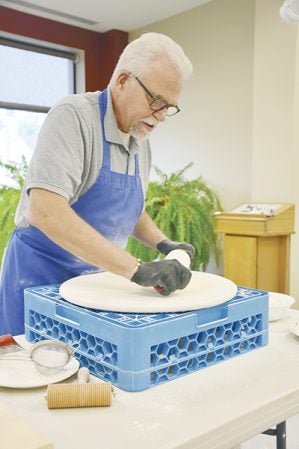
Jim Braaten is a volunteer who has lent his talents to lefse rolling for several years.
Once done, another volunteer collects the lefse, and quickly puts it under towels to keep them moist — a too-dry lefse round is not good. Nor is one that is took dark — an occupational hazard when cooking next to friends.
“When I start talking and keep it on the griddle too long, then, it’s ‘Oh, too bad! Guess we’ll have to eat that one!’” Akkerman said with a laugh.
Most eat lefse with butter and white sugar, although “you can put anything you want on it,” said Bishop.
The lefse has to pass inspection. Karen Olson was one of the “quality control” cooks who took the lefse and laid them to cool, keeping an eye on the general appearance and quality of cooking. Then another group packages the rounds, which are then frozen until the time of sale.
Olson carefully scanned each one, keeping an eye out for imperfections. Even though she is of Swedish heritage, Olson said, “I work well with the Norwegians,” she said, chuckling.
Akkerman, looking around the work stations, said lefse is almost ingrained in the Norwegian soul.
“My mother used to cook them right on a wood stove,” Akkerman said. “She’d scrub and scrub the top of the stove to make sure it was clean, and then she’d make them there.”
She chuckled when thinking of dinners she attended in her childhood when lutefisk — that Norwegian cod delicacy that is soaked in lye during its preparation — was also served.
“They would take the lefse, put mashed potatoes on it, then top it with the lutefisk, wrap it all up — a lefse taco,” she said, laughing. “Then it would all run down your arm while you were trying to eat it.”
Festival is Oct. 14
The annual Scandinavian Festival and Bazaar will be from 9 a.m. to 2 p.m. on Saturday, Oct. 14 at the church. In addition to its bake sale, there are crafts, cookbooks, RADA cutlery, fair trade coffee, a holiday shop and greeting cards all for sale. Coffee and lunch is served all day.
The church is located at 306 Second St. NW in Austin.





